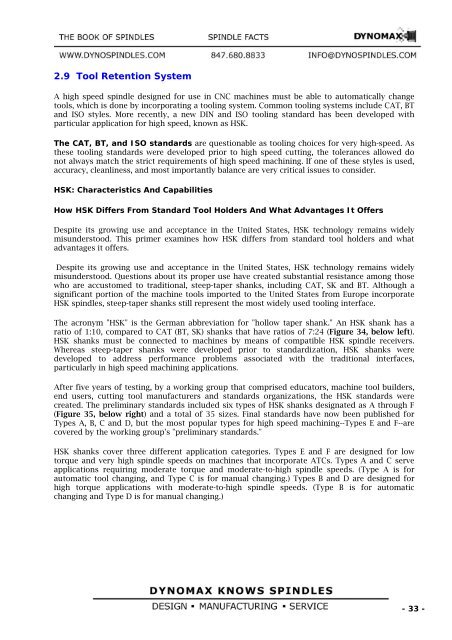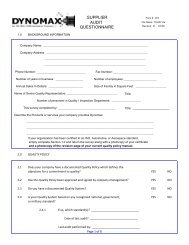You also want an ePaper? Increase the reach of your titles
YUMPU automatically turns print PDFs into web optimized ePapers that Google loves.
2.9 Tool Retention System<br />
A high speed <strong>spindle</strong> designed for use in CNC machines must be able to automatically change<br />
tools, which is done by incorporating a tooling system. Common tooling systems include CAT, BT<br />
and ISO styles. More recently, a new DIN and ISO tooling standard has been developed with<br />
particular application for high speed, known as HSK.<br />
The CAT, BT, and ISO standards are questionable as tooling choices for very high-speed. As<br />
these tooling standards were developed prior to high speed cutting, the tolerances allowed do<br />
not always match the strict requirements of high speed machining. If one of these styles is used,<br />
accuracy, cleanliness, and most importantly balance are very critical issues to consider.<br />
HSK: Characteristics And Capabilities<br />
How HSK Differs From Standard Tool Holders And What Advantages It Offers<br />
Despite its growing use and acceptance in the United States, HSK technology remains widely<br />
misunderstood. This primer examines how HSK differs from standard tool holders and what<br />
advantages it offers.<br />
Despite its growing use and acceptance in the United States, HSK technology remains widely<br />
misunderstood. Questions about its proper use have created substantial resistance among those<br />
who are accustomed to traditional, steep-taper shanks, including CAT, SK and BT. Although a<br />
significant portion of the machine tools imported to the United States from Europe incorporate<br />
HSK <strong>spindle</strong>s, steep-taper shanks still represent the most widely used tooling interface.<br />
The acronym "HSK" is the German abbreviation for "hollow taper shank." An HSK shank has a<br />
ratio of 1:10, compared to CAT (BT, SK) shanks that have ratios of 7:24 (Figure 34, below left).<br />
HSK shanks must be connected to machines by means of compatible HSK <strong>spindle</strong> receivers.<br />
Whereas steep-taper shanks were developed prior to standardization, HSK shanks were<br />
developed to address performance problems associated with the traditional interfaces,<br />
particularly in high speed machining applications.<br />
After five years of testing, by a working group that comprised educators, machine tool builders,<br />
end users, cutting tool manufacturers and standards organizations, the HSK standards were<br />
created. The preliminary standards included six types of HSK shanks designated as A through F<br />
(Figure 35, below right) and a total of 35 sizes. Final standards have now been published for<br />
Types A, B, C and D, but the most popular types for high speed machining--Types E and F--are<br />
covered by the working group's "preliminary standards."<br />
HSK shanks cover three different application categories. Types E and F are designed for low<br />
torque and very high <strong>spindle</strong> speeds on machines that incorporate ATCs. Types A and C serve<br />
applications requiring moderate torque and moderate-to-high <strong>spindle</strong> speeds. (Type A is for<br />
automatic tool changing, and Type C is for manual changing.) Types B and D are designed for<br />
high torque applications with moderate-to-high <strong>spindle</strong> speeds. (Type B is for automatic<br />
changing and Type D is for manual changing.)<br />
- 33 -



